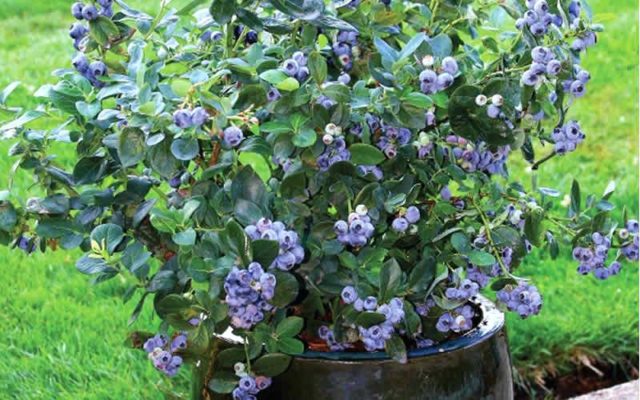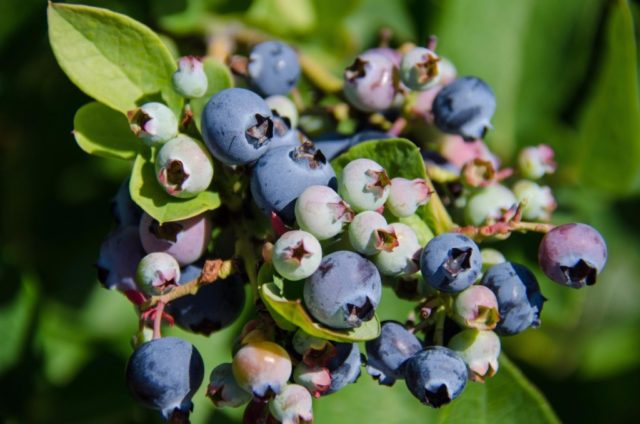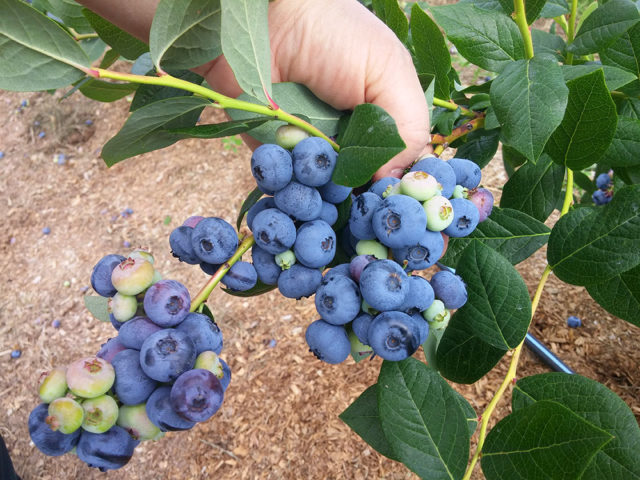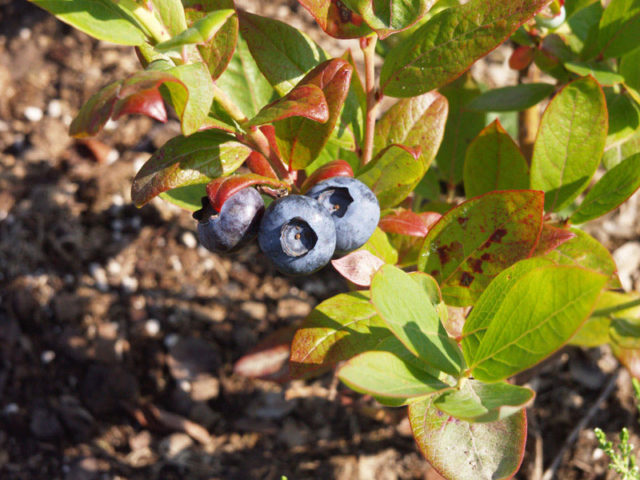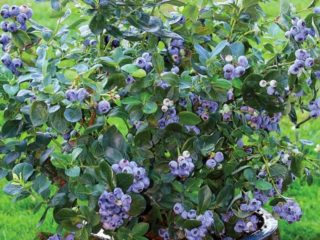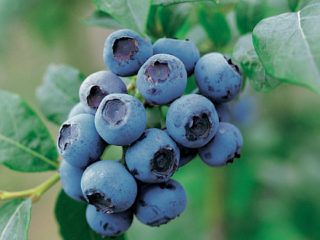Content
Planting and caring for garden blueberries is a process that requires a very careful approach. Growing blueberries is not easy, but if successful, the plant will regularly delight you with delicious, sweet berries.
General description of garden blueberries
Garden blueberry is a small shrub; the height of a blueberry bush is a maximum of 1 m. The plant is valued for its edible blue berries with a bluish bloom.
What do blueberries like?
Under natural conditions, blueberries grow throughout the western part of Russia, Siberia and the Urals. Most often it can be found in coniferous forests and on the outskirts of swamps. Therefore, the plant prefers moist soils and slightly shaded areas with sufficient lighting.
The shrub is very undemanding in terms of soil composition - it can grow successfully even on poor soil, as long as it is slightly acidified. The plant also requires protection from strong winds - in winter it can easily die in strong drafts in open areas.
How garden blueberries bloom
Blueberries usually bloom in the third year after planting. The plant produces small white flowers, drooping towards the ground, in the shape of jugs, with a pinkish tint. The flowers are collected in inflorescences of 5-12 pieces each, usually located at the tops of the stems. Flowering continues from late May to mid-June.
What year do blueberries bear fruit after planting?
The first harvest can be harvested 4-5 years after planting. Blue berries with a bluish coating, collected in small clusters, appear in July-September, but remain on the branches after ripening for only about 2 weeks, and after that they begin to fall off.
Secrets of growing blueberries
It is quite possible to grow blueberries in your summer cottage, but it is more difficult to get a high-quality harvest from them. To ensure that the bushes of the plant do not die in the first few years, develop successfully and bear fruit, it is necessary to follow the basic rules of cultivation. Namely:
- Water the plant more often; the shrub does not like soil that is too swampy, however, it does not tolerate dry soil very well, so the soil at the roots should always be moist;
- plant bushes at a distance from each other, the root system of the plant is branched, if you place the bushes close to each other, they will grow poorly;
- monitor the acidity level of the soil - the plant likes at least 4 pH.
Also, advice from experienced gardeners on caring for blueberries in the spring recommends ensuring good soil drainage. If the water in the roots of the bush stagnates, the plant will not be able to develop normally.
What can you plant blueberries next to?
Site neighbors for plants must be selected based on soil requirements. In particular, you can successfully grow next to blueberries:
- lingonberries and cranberries;
- rhododendrons and hydrangeas;
- azaleas;
- heather crops.
But raspberries, gooseberries and currants will turn out to be bad neighbors for blueberries. They prefer alkaline soil and, accordingly, will not be able to get along with berry bushes in one area.
Is it possible to plant blueberries next to thuja?
Coniferous trees, including thuja, are considered to be bad neighbors for other plants in the garden. However, in the case of blueberries, the opposite is true; they feel quite good next to the thuja. The reason is the same plant requirements for soil: both thuja and fruit shrubs love acidic soils, so they can grow side by side without any problems.
Some tips on what you can plant between blueberry rows
It is customary to plant blueberries in rows with wide intervals - this allows the bushes to actively develop without interfering with each other.
To ensure that there is no unsightly unoccupied space left on the site, it is customary to plant mostly perennial grasses between the rows of bushes. First of all, they allow you to maintain the decorative appearance of the garden, and, in addition, they can serve as a natural mulch layer in the autumn, after withering.
Photos and reviews about planting and caring for garden blueberries also suggest planting juniper, rhododendron, and hydrangeas between the rows of blueberries. These plants have a shallow root system, do not take away too much moisture from the fruit bush and do not rise high above the ground; therefore, their shading is insignificant.
How to save blueberry seedlings for planting
It is best to buy seedlings of garden shrubs in the spring, shortly before planting in the ground. However, it also happens that planting material was purchased in the fall or early winter. In this case, the question arises of preserving seedlings until the beginning of the growing season.
- If the root system of the seedlings is closed, then for the winter it is best to transplant it from a purchased container into a more spacious pot. It is best to use acidic peat as a nutrient medium; the seedling should be transferred to a new container with an old lump of earth. Until spring, the pot with the plant must be left in a well-lit but cool place.
- If the root system of the seedling is open, then during the winter months it must be constantly moistened so that the roots of the plant do not dry out. Typically, bare-rooted seedlings are wrapped in damp newspapers and covered with a plastic bag, after which they are put in the refrigerator. Newspapers need to be replaced regularly with new ones, preventing them from drying out.
At low positive temperatures in the refrigerator, open seedlings can begin to grow. However, placing such planting material in pots is still not recommended.
How to plant blueberry seedlings in spring
Planting blueberry seedlings in the spring is an important step in growing the plant. Particular attention must be paid to the timing of planting and the creation of seats.
The most important rule is that you must adhere to a proven planting pattern. Since the root system of the plant grows in breadth, the bushes of the plant must be planted at least 1-1.5 m from each other. The distance between the rows should be 1.5 m or 2 m.
When to plant blueberries in spring
Garden blueberry bushes are usually planted in early spring, even before active growing season begins. It is best to wait until the snow melts and the ground warms up to about 5 °C.
However, these recommendations concern mainly the South of Russia and the middle zone. But in the Urals, Siberia and the north-west of the country, the plant should be planted no earlier than in early May; the soil in these regions warms up much more slowly.
Is it possible to plant blueberries in summer?
Theoretically, it is possible to plant garden shrubs in the summer. Moreover, for the Urals and Siberia it is often recommended to use just such a planting so that return frosts do not destroy the young bushes of the plant.
However, summer planting should be done in moderately warm and cloudy weather, and not in the midst of the heat.
Where to plant blueberries
Many gardeners mistakenly plant shrubs in heavily shaded and even swampy areas of the garden, trying to create the most “natural” conditions for the plant.This is a mistake; when growing blueberries in a country house, the plant makes different demands on its habitat.
So, it is necessary to plant blueberries in areas with sufficient lighting - if you place them in dense shade, the bushes will not wither, but they will not be able to bear fruit. Also, the soil at the roots of the plant should not be over-moistened - the shrub does not tolerate swamps, the soil should only be moderately moist.
Preparing a hole for planting blueberries
In order for garden blueberries to grow healthy and bear fruit in a summer cottage, it is necessary to properly prepare the planting hole.
- In a well-lit or slightly shaded area, dig several holes with a depth of about 45 cm and a diameter of at least 90 cm. The roots of the plant go shallow into the ground, but they need a lot of space in the horizontal plane.
- Suitable drainage is provided in the holes - chips of pine bark are placed on the bottom, which will ensure good air exchange and water drainage, and at the same time acidify the soil. The drainage layer should be approximately 5 cm.
- High-acidic peat is poured on top of the drainage layer; it will form the basis of the soil. Peat can be mixed with a small amount of fine sand or rotted sawdust.
- A little ordinary soil is added to the peat; it should not be heavy; loamy soil is ideal for the plant.
If desired, you can dig not only planting holes for blueberries, but also trenches, in which case the bush will also serve as a hedge.To construct a trench, dig a long hole about 1 m deep in the right place and, according to the standard scheme, arrange drainage in it and fill it with soil.
How to plant garden blueberries in spring
Before planting a plant in the ground, it is necessary, first of all, to prepare the seedling. To do this, take it out of the pot if the root system is closed, or out of the bag if the system is open, and carefully examine the roots.
It is enough to place a seedling with bare roots in a container of water for a short time. If the roots are in the ground, then you need to assess their condition. If they entwine the earthen ball very tightly, then the roots can be slightly stirred without injuring them, so that the garden blueberries will quickly take root in the new place. Before planting, it is also recommended to soak such a seedling in water.
The landing algorithm itself looks like this:
- in the prepared holes, small depressions are made according to the size of the seedlings;
- Plants are placed in the holes with or without a ball of earth and, if necessary, the roots are carefully straightened;
- the garden blueberries should be slightly below the edge of the hole, after which the roots can be completely covered with soil;
- The soil around the planted bush will need to be crushed, and then watered and mulched generously.
After planting blueberries in a summer cottage, it is recommended to trim them slightly and remove fruit buds so that the plant can use its resources to grow roots and green mass.
How to grow blueberries in a country house or on a plot
Caring for blueberries in spring and summer is quite simple - it is important to adhere to the most basic rules. If the place for the shrub is chosen correctly, then the garden blueberry will quickly take root and begin active growth, and will soon be able to please you with fruiting.
How to water blueberries
It is especially important to water blueberries frequently during the first time after planting; it is necessary that the water thoroughly saturates not only the soil nearby, but also the dense earthen lump at the roots. The soil under the bushes of the plant should always be moist, and the successful establishment of seedlings will be indicated by the appearance of new shoots.
Caring for blueberries in summer involves watering at least twice or thrice a week, in extreme heat and, especially during fruiting, daily. It is also very useful to spray garden blueberry bushes - but this should be done early in the morning or in the evening, when the bright sun has already left the site.
Mulching the soil
The soil around blueberry plantings must be mulched. Mulch prevents the rapid evaporation of moisture from the soil and improves the acid composition of the soil.
The following are well suited for mulching garden blueberries:
- sawdust and chopped bark;
- peat and sand;
- foliage, hay and straw.
However, you need to be aware of some nuances. Mulching blueberries with sawdust and bark is not recommended in the spring, as they will reduce the nitrogen content in the soil.Hay and straw can only be used on light soils; if blueberries grow on loam, then such mulch will make the soil too heavy and contribute to waterlogging.
The thickness of the mulch layer should be about 10 cm, and the mulch should be spread within a radius of at least 1 m from the bush in all directions. For the first time, blueberries are mulched immediately after planting, but subsequently, when the mulch layer is re-laid, its density can be reduced to 5 cm.
Rules for feeding and pruning
For healthy development, garden blueberries need fertilizing with minerals - nitrogen, potassium and phosphorus. It is recommended to introduce it from 2 years after planting; before that, the bushes have enough nutrients originally contained in the soil. Garden blueberries are fertilized with complex fertilizers mainly in the spring, after the growing season begins.
From 3 years of life, a garden plant requires regular pruning, mainly sanitary, during which weak and diseased branches of the plant are removed. Pruning is carried out in early spring before the buds open. When trimming bushes, it is necessary to cut off not only weak and dry branches, but also small growths located close to the ground, as well as dense branches in the middle of the bush.
Pests and diseases
Blueberries are quite resistant to garden pests and are rarely affected by insects. However, in the spring, May beetles and beetles, which eat foliage and flowers, can be dangerous for her. Sometimes scale insects, aphids, leaf rollers and pine silkworm caterpillars settle on the leaves of the bush.
To get rid of pests, it is recommended to use insecticidal agents such as Actellik or Karbofos.It is best not to wait for insect damage, but to treat the plants prophylactically - spraying should be carried out in early spring and after fruiting.
As for fungal diseases, garden blueberries most often suffer from the following diseases:
- gray rot;
- double and white spotting;
- stem cancer and drying of branches;
- physalsporosis.
Almost always, diseases appear due to waterlogging of the soil, so it is necessary to especially carefully monitor the frequency of watering the plant. If illnesses do appear, the plant must be treated with fungicidal preparations, for example, Fundazol or Topaz. It is recommended to carry out annual spring and autumn treatments with Bordeaux mixture for preventive purposes - in the fall you need to spray garden blueberries after harvesting.
Conclusion
Planting and caring for garden blueberries is associated with certain difficulties. But if you follow the basic rules of care and follow the special secrets of growing, then the fruit bush will be able to please you with a bountiful harvest just a few years after planting.
